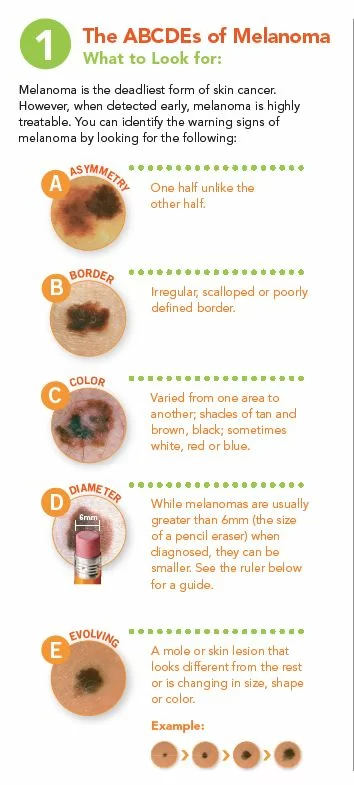One American dies from melanoma every hour of every day. While melanoma is not the most common of skin cancers it causes the most deaths…over 9000 people in the US annually. This is especially tragic given the fact that if recognized and treated in the early stages, it is almost always curable.
What is Melanoma?
Melanoma is characterized by the uncontrolled growth of melanocytes (pigment cells). Melanocytes produce melanin, the pigment that colors our skin, hair, and eyes and allows our skin to darken (tan) when exposed to UV light. Most melanomas arise in the skin but may also occur in the eye, digestive tract, or central nervous system. Cutaneous melanomas are found most frequently on the backs of men and on the legs of women, but can occur anywhere on the body.
Who does Melanoma affect?
Melanoma can strike anyone, although Caucasians are significantly more likely to receive the diagnosis. Other risk factors include UV exposure (sunlight or tanning booths), history of blistering sunburns, dysplastic nevi, large numbers of ordinary moles, red or blonde hair, blue or green eyes, very fair skin, personal or family history of melanoma and weakened immune system.
How can Melanoma be prevented?
Sun exposure is the most preventable risk factor for all skin cancers, including melanoma. Sun smart tips include:
- Generously apply a broad-spectrum (SPF 30 or greater) sunscreen or block and re-apply every 2 hours or after swimming, sweating or toweling off.
- Wear sun protective clothing including a wide brimmed hat and sunglasses with UV absorbing lenses
- Seek shade and avoid midday sun (10am-4pm),
- Take extra precautions near water, snow and sand
- Avoid tanning booths.
It is also wise to examine your own skin monthly, as recognition of changes in the skin is the best way to detect early melanoma. A changing mole, a new mole, or a mole that is “different” or begins to grow requires prompt medical attention. The ABCDE rule outlines the warning signs of melanoma: Asymmetry, Border irregularity, Color (more than one color), Diameter (>6mm or a pencil eraser) and Evolving or changing. Patients at high risk should undergo complete skin exams by a dermatologist at least annually.
What are the treatment options for Melanoma?
Treatment and prognosis depends on how far the disease has advanced. Surgical removal of thin melanomas can cure the condition in most cases. More advanced stages may require lymph node removal, immunotherapy, targeted therapy, chemotherapy or radiation. Rapid advances in the past seven years have resulted in an array of FDA approved treatments that benefit patients with metastatic melanoma.

